#human evolution
Note
It’s kinda sad we’re the only ones left. I get kinda existential when I look at fossilized specimens and reactions of other human species. At the same time, Sapiens and Neadrethals being so horny for each other one doesn’t exist anymore will always be kinda funny to me
It's definitely sad. It's also why anthropocentrism exists- the only way we could possibly justify the idea that we are different from other animals is because we don't have any close relatives. You would never see raven-centrism from a raven, because crows exist. Between our profound isolation phylogenetically, our brains inability to not find patterns (to the point that we find them where they don't exist), and to create "archetypes" in our brains to summarize different phenomena, we were on a collision course for a culture built on hierarchies and stereotyping and narcissism.
That said, it will be forever funny that all the different close-to-sapiens species that existed in the recent time just got folded into H. sapiens. The power of Love!
315 notes
·
View notes
Text
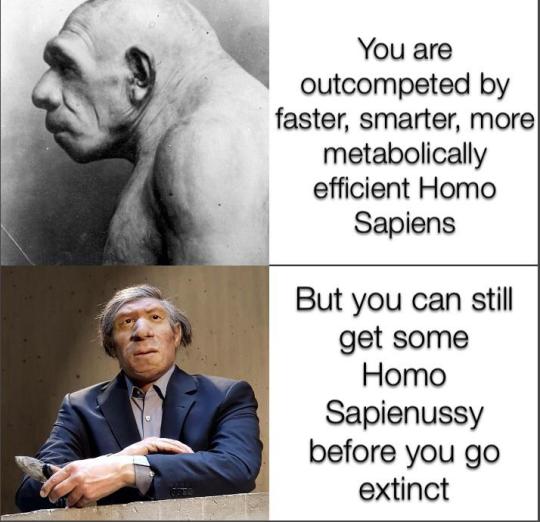
#reddit aint too bad sometimes#anthropology#memes#biology#science#ussy#human history#evolution#human evolution#evolutionary biology#paleoanthropology#paleontology#homo neanderthalensis#neanderthal man#neanderthals#homo sapiens#history
336 notes
·
View notes
Text
Let's take a closer look at the hominin skulls in the Senckenberg Museum's human evolution room. Keep in mind this is not a linear progression through our ancestors, and more like a bunch of closer and more distant cousins.


The first one, Sahelanthropus tchadensis is seven million years old, and may very well not be a hominin at all. I've always leaned towards the hypothesis that it's a gorilla relative, not one of ours. No matter which branch of the apes it belongs to, it lived not long after the time the human-line (hominins) and the chimp-line separated, and possibly even before that point!


Ardipithecus ramidus, the first hominin from where we can start making a fairly decent family tree of our relatives. Before this point, 5 million years ago, hominin fossils are very rare, fragmentary, and difficult to assign. One of the most interesting things that does seem to emerge from these early fossils is that we have walked on two legs for a long time. Maybe even so long that our common ancestor with the chimps and bonobos did it!

Lucy represents Australopithecus afarensis, who shows up at this point (3.3 million years ago).


Australopithecus africanus, the Taung child to be precise. We're about 2.8 million years ago at this point. Australopithecines must've been such fascinating creatures.
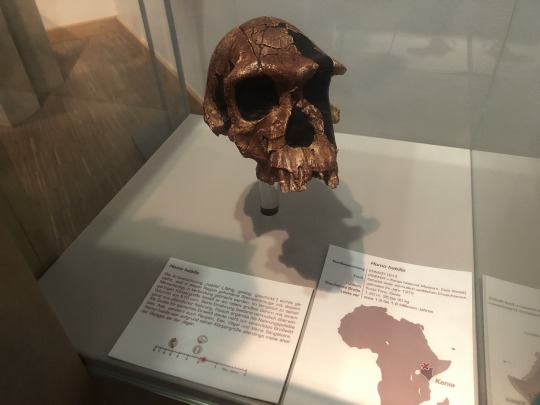

Homo habilis, the 'handy man', named that way because when they were discovered they were thought to be the first humans who used tools. Since then, Australopithecus tools have been found, and tool use by many different animals has also been documented.
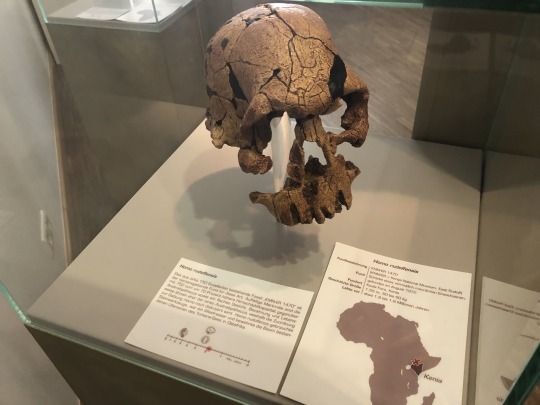

Homo rudolfensis, a population of humans who lived at the same time as Homo habilis and were notably bigger and a little brainier. Does it warrant being its own species? That depends who you ask. Splitting vs lumping is a point of contention in almost every group's biology, and it can run especially high in the field of human evolution since hominins are A very high profile and important fossils that directly relate to our own origins, and B an extremely tangled group that seems to have produced loads and loads of isolated populations and subspecies that regularly migrated all over the place and had frequent interbreeding events. Personally I tend to come down on the side of lumping them into a few major species.


Paranthropus boisei. These were basically a separate lineage of australopithecines, quite different from our own ancestors, who continued to do australopithecus things until quite recently. They were very good climbers and seem to have returned to the trees.

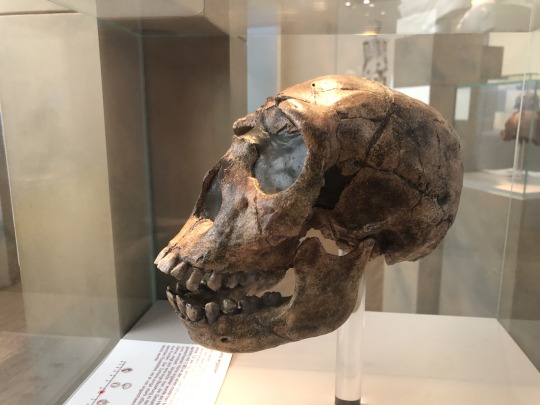
Homo ergaster, either a close relative or a synonym of the more famous Homo erectus. This is the point where we got really brainy, probably figured out how to make fire ourselves, and spread from Africa to Eurasia.

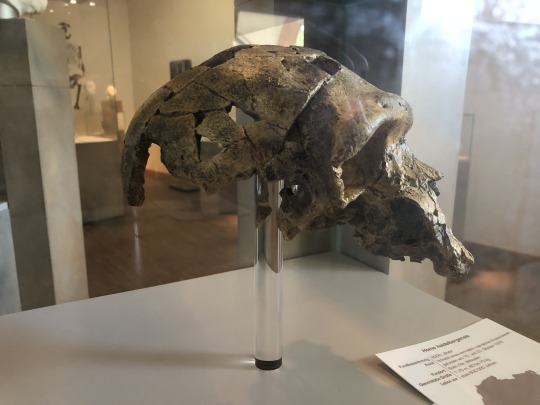
Homo heidelbergensis. Homo erectus and its many subspecies spread all over Africa and Eurasia and existed for well over a million years. As time marches on and evolution did its thing, we eventually start calling the ones in Africa Homo heidelbergensis. They were quite tall, positively enormous compared to little Lucy a few million years back, and they too joined in the human migrations out of Africa. From the H. heidelbergensis who moved into Eurasia we eventually get neanderthals and denisovans, while Homo sapiens evolved from the heidelbergensis populations in Africa.
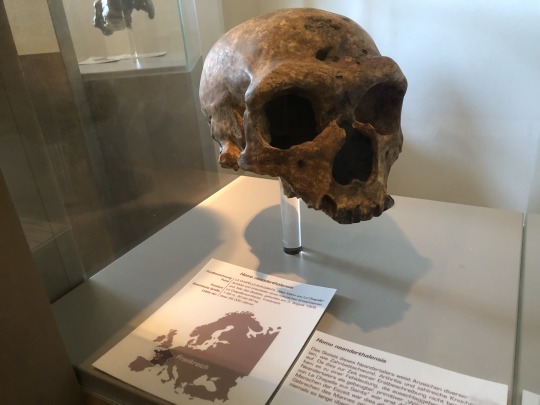

And there's the neanderthals! Large-brained and creative (the first known cave paintings belong to them and they buried their dead), they were likely quite different from the brutish image we often get from them. Rather than truly dying out, their populations eventually merged with the larger Homo sapiens population once they migrated out of Africa, leaving our modern genes with a couple percent neanderthal DNA.
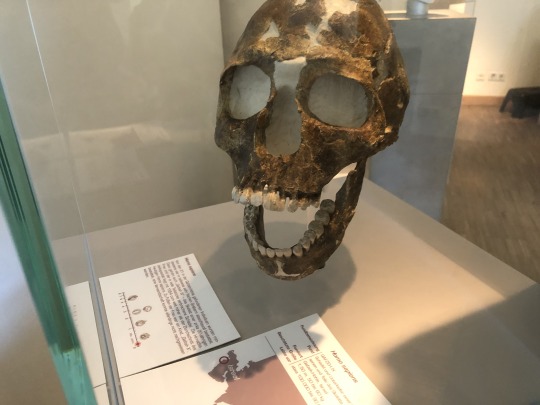
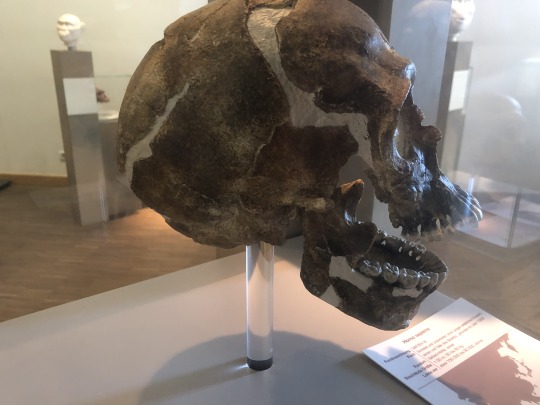
Homo sapiens. And that's us! Not so much the last remaining branch of the human family tree as much as several of the separate branches ended up coming back together and weaving into a single bigger branch.
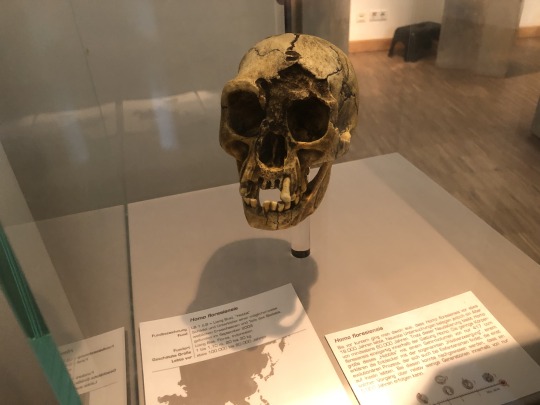

And then there's these little guys, Homo floresiensis! Probably originating from a Homo erectus population that ended up on the island Flores, insular dwarfism ended up making them grow quite tiny. On their isolated island, they remained until about 50000 years ago.
#human evolution#sahelanthropus#ardipithecus#australopithecus#homo#ape#primate#mammal#neogene#quaternary#palaeoblr#senckenberg museum#vicky's vritings
324 notes
·
View notes
Text
Groundbreaking genetic research reveals a near-extinction event of our human ancestors around 930,000 years ago. From 100,000 breeding couples to just 1,280!
#evolution#human genome#ancestors#genetics#extinction#population#climate change#human evolution#ancient#history#ancient origins
119 notes
·
View notes
Text
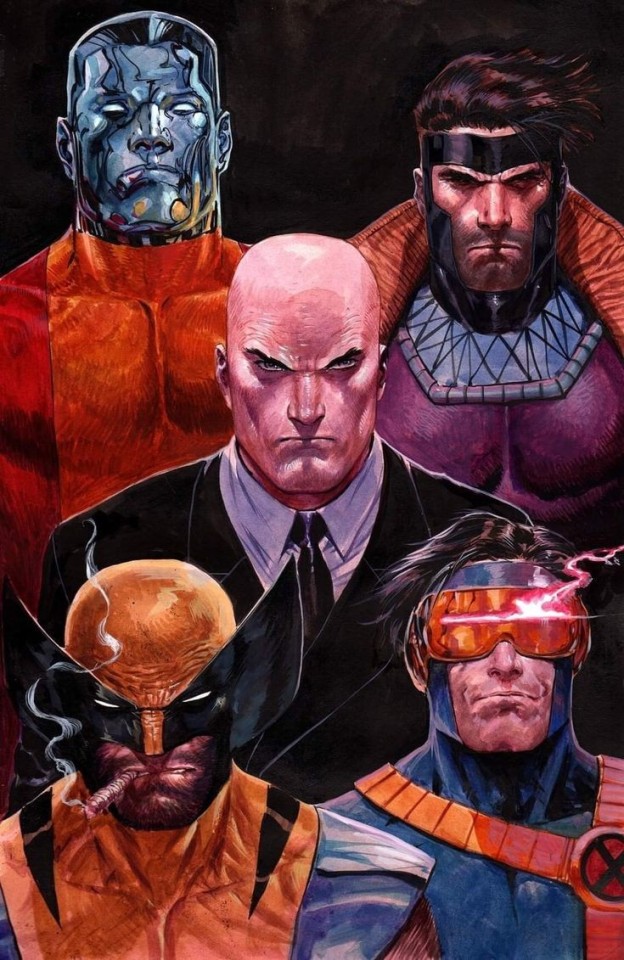
#professor x#colossus#gambit#wolverine#cyclops#xmen#uncanny xmen#x men#charles xavier#peter rasputin#remy lebeau#james howlett#scott summers#mutants#weapon x#mutant kind#man kind#human evolution#marvel mutants#marvel comics#marvel
87 notes
·
View notes
Text
Neurodiversity from an Evolutionary Perspective
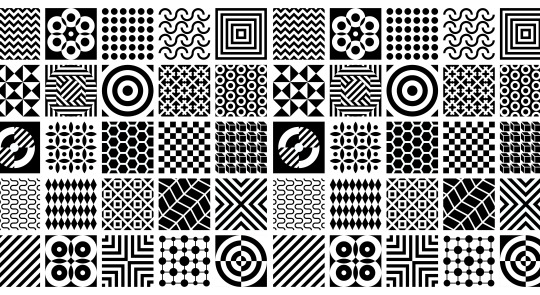
I spoke yesterday about how neurodiversity is a bit of Schrödinger's Disability today. We neurodiverse people get all the backlash of being diabled, and all the discrimination, but we rarely get disability benefits of any sort.
But today I want to talk about something else: Evolutionarily speaking most neurodiverse people are not disabled. Our disability stems entirely from the fact that we just do not function in a 9-5 capitalist hellscape.
Just look at it from the perspective that our species actually evolved to gather and hunt - and maybe also cultivate some stuff. (Given how long ago we did that, you could argue that this also shows in our genes.)
See, by now a lot of specialists think, that both autism and ADHD are very underdiagnosed, because even within the field a lot of people are looking for a certain, stereotypic way for the neurodiversity to show. With modern diagnostic criteria there is a good chance that about 5% of all people have ADHD and/or autism. Which is... a lot.
But the thing is that it actually makes a lot of sense. Because evolutionarily it would totally have been an advantage.
Let me talk about something we did at university yesterday. We got a lot of random shapes on a picture and we were supposed to find the T and the X between these shapes. Something I could do within less than a second, while three of my fellow students were unable to find the T (which was rotated) at all. Because my brain processes visual information completely differently.
And this... is evolutionarily an advantage, right? Just imagine being a hunter-gatherer and going through the forest or the savanna. And now you have someone among you, who is able to see a prey animal instantly, because of how they process visual information. Or who realizes them being stalked by a predator. Or them finding fruits and other things.
Neurodiverse people are also very capable of having a very different approach to problem solving. Which again would have a small tribe easier survive. Doubly so with the hyperfocus that neurodiverse people can have. Which totally is an evolutionary advantage for a group to have. Who knows. Maybe the first person to make fire was a neurodiverse person hyperfocusing on this task.
Also, there is the very common believe that people with ADHD specifically were probably very well adapt at hunting for several reasons.
So, yeah. This is so very common, because evolutionarily it was an advantage. From an evolutionary perspective it makes sense that it is so very common.
You have to remember: Modern Homo Sapiens as a species is around 160 000 years old. We settled down sometime between 10 000 and 15 000 years ago. So, just from an evolutionary perspective us having settled down is a very, very new thing. And not to mention, that the modern working culture has been around for not even quite 100 years. Office jobs have been a thing for even less.
And I can tell you: If you leave me out and about outside. I am good. Like, give me some nature observatory duty or something, putting up trail cams, what not. I am good. I can work for 12 hours straight (because hyperfocus). But sit me in the office for just 6 hours, and you will have me crawling up the walls, because that is just not what my brain does.
Ideally I am gonna need a job, that involves a lot of research and going outside. Which is why I hope to either go into Digital Humanities or the Environmental Geoinformatics. Because that is stuff I work well with.
If you gotta put me in an office job, you might as well shoot me right. Because my brain just doed not work like that.
145 notes
·
View notes
Text
R/systemscringe found my Evolution Post... And Was Too Lazy to Add a Title

You can find my evolution post here!
Let's check out the comments!

Sure. But we're not talking about a normal modern job, are we?
Who you are at home isn't going to be that different from who you are at McDonalds. You aren't usually going to dissociate the two.
But when trauma is involved, that tends to involve a degree of dissociation.
In modern hunter-gatherer societies, we see children start learning how to use tools and hunt and forage in the wild from a very young age.
If we're to extrapolate and assume past hunter-gatherer societies operated in similar ways, this is a recipe for a traumatic childhood in a world where humans wouldn't yet be at the top of the food chain. Children would need to be careful, and a wrong move could easily get them or someone else killed.
I think most systems during this period would be considered traumagenic simply because growing up would mean regularly being put in deadly situations, regularly being injured and even watching loved ones dies in violent ways.

THAT'S the point!!!
DID, and even PTSD, evolved in a world where every day would be a fight for survival.

Of course, all we can do is speculate.
But with myths and legends of people being possessed going back to the dawn of time in practically every culture, we can probably surmise that forms of plurality existed back then. And it's not like the estimated 1-3% of the population is super rare today. It seems reasonable to expect disorders that would be associated with childhood trauma would be more common during periods with more childhood trauma.
The line saying we don't know if the brain was developed enough to develop DID is particularly weird to me though.
As far as I know, there haven't been any huge jumps in the way of human brain complexity over the past 20k years. I doubt that the complexity to develop DID is something we just gained since the dawn of agriculture.

I admit, my description was meant to put a fun spin on a brutal reality. But I don't think children growing up in a frigid environment where they need to hunt and collect food to survive while having no idea if they're going to make it back alive is "cool".
Like, as a story, maybe it's cool imagining a 9-year-old trudging through snow with fingers so cold they can't feel them anymore, gripping a makeshift spear and hearing howling in the distance while not knowing if they would end up on the menu of some wild beast.
But I don't think it would actually be cool to live through.
Additionally, in this environment, DID would have looked differently than it does today. Current theories are that EPs are locked into the trauma responses they used in trauma.
For child abuse victims which make up the majority of DID cases, unfortunately, freeze or fawn may be the most useful traits developed for survival.
But if your trauma were related to surviving wild beasts, it's a lot more likely the trauma responses of the EPs are going to be the more classic fight or flight. I don't think freezing would as common as a trauma response during that time period. But of course, it depends on the threats one would face.
There are some creatures, after all, where freezing is the best defense.

Sounds like your mistake. 🤷♀️
I talked about DID here a lot, but I'm a tulpa from a purely non-traumagenic system. Probably one of the least traumatized people you'll ever meet.
But tulpamancy is a beneficial practice that most tulpamancers have reported improvements in their mental health from. I would actually like to see far more people make headmates and become plural this way.
People becoming tulpamancers will help them. And more plurals means more influence for the plural community and will help spread plural awareness and acceptance.
I'm not interested in being special. I'm interested in making plurality normal. I want it to be so normal and commonplace that it seems downright boring. Where talking about your headmates draws no more attention than discussing a sibling. 😁

Hi! It's me! I'm Sophie In Wonderland!
I'm the person who debunks pluralphoboic hate subreddits, which tends to upset said hate subreddits.
The reason why I have my own category is because I called out the subreddit for bullying behavior and misinformation. They responded by doubling down, scouring my post history for anything they could use as ammunition twist to attack me with, and adding me to their hit list of acceptable targets. This was despite the fact that then they first floated the idea of the hit list, they claimed it would only apply to people with more than 10,000 followers. (I only have 1800.)
They lie and claim I'm a "public figure" while in reality, they added me on their list in a petty (yet oh so predictable) act of retaliation.
#syscourse#evolution#multiplicity#human evolution#systems#system#psychology#psychiatry#pro endo#pro endogenic#systemscringe#r/systemscringe#systems cringe#hate group#hate groups#r/didcringe#endogenic#system stuff#sysblr#actually a system
46 notes
·
View notes
Photo

I gave my “Evolution of Woman” artwork from 2020 a few retouches today. It’s still one of my favorite artworks that I’ve ever done.
#human evolution#paleoanthropology#hominins#hominids#african#black women#women of color#dark skin#digital art#art
121 notes
·
View notes
Text
"The imperative of protecting the vulnerable young in a predator-rich environment no doubt played a major role in shaping human sex differences and sexuality. La difference - the sexual dimorphism characteristic of humans and many other animals - is now believed to reflect, in large part, the greater role of males in actual combat with predators. Hunting, too, if it were a male-only activity, would have favored bigger, stronger males. But long before the male hunting band, males were probably deployed as baboon males are: to guard the periphery of the group." - Barbara Ehrenreich, Blood Rites.
Some years back I read a post about how war is basically an exercise in sending barely adult young men to kill each other, but this is made more palatable by honoring the young men used so. Blood Rites seems like basically an attempt to offer a theoretical model of the origins of that behavior; not so much the origins of the war part as the origins of the honoring part.
I've only read the parts I could find for free on the internet cause my local library doesn't seem to have the book and my financial situation is not great so I'm reluctant to buy it, I'm wondering if she talks more about how her theory relates to gender, especially masculinity, cause, like...
... Yeah, let's talk about those hypothetical proto-humans making their camp in the Pleistocene savanna, deploying in that gendered defensive formation, the fighting age adult males deployed in a ring at the periphery of the camp, clutching their sharpened sticks and stone hand axes (the mightiest human weapons of this era), deployed out there to watch for and defend against and absorb the violence of the savanna's predators, while the more vulnerable immature young and more demographically valuable females and the few elders who've managed to live long enough to become enfeebled get the relative safety of the camp's center.
If the masculine gender role originally emerged from that situation, I think that would explain a lot about what it looks like! In the context of that defensive formation might emerge association of maleness with combat and an idea that able-bodied adult males should participate in group violence, masculine protectiveness toward women and children and division of humanity into fighting men and protected ones (women, children, the old and disabled), valuing and honoring of courage in combat especially in males, shaming and ostracism and punishment of young males who very understandably show noticeable reluctance to leave the relative safety of the group's core and take a place in the peripheral defensive ring when they reach maturity, females using gifts, affection, and sex as ways to reward males who show willingness to put themselves at risk for the sake of the group, honoring of heroes (the male who drove a sharpened stick into the lioness's side), honoring of the memory of martyrs (the male who threw little stones at the dinofelis and drew its hunger and rage down upon him so it would kill him instead of a woman or a child).
There's a paragraph, like, right after that quote that speculates that human playful/social non-reproductive sexuality may have evolved in that context, which, yeah, if we're going to talk about the gendered aspect of this we should talk about some of the stuff I talked about here. When I first conceptualized the first sentence of my response to that quote the phrasing that bubbled into my mind was "barely legal adult," which, lol, "barely legal" is a porn category, usually meaning an 18 year old young actress IIRC, but actually I think there might be something in noticing that parallel, pulling on that thread! Also, I see a possible intersection with the Sex At Dawn kind of monogamy as a relatively recent innovation hypothesis in this. In this gendered anti-predator defense formation males would work together to defend the females and immature young of the group as a collectivity. If you're going to use male-female sexual bonding to strengthen that relationship, it would probably work better if it was polyamorous so most or all of the group's fighting males would feel that attraction-affection-gratitude-protectiveness tangle of emotions toward many of the group's females.
Re: hunting hypothesis vs. defense hypothesis for the origins of human organized violence, which is something Ms. Ehrenreich talks about (she's strongly on the side of the defense hypothesis) - as I pointed out here, I think the human tendency to honor courage is suggestive; courage is the virtue of a prey species that engages in collective defense; a smart predator attacks the weak, avoids fights with the strong, and quickly retreats if it loses the advantage. Then again, bravery is also useful in intra-species competition, so that's not conclusive (notably, I think the "a smart predator isn't brave" thing isn't so obvious to a lot of humans because present and recent historical human hunting is often partly an intra-species social activity oriented toward gaining prestige by killing big, strong, dangerous animals and taking impressive trophies). I also think that stuff like that visceral dislike of deserters David Graeber talked about fits better with this model. Like, yeah, I guess big game hunting might have been vital to survival sometimes, but it's hard to see "all men must be hunters!" as a strong imperative unless it's really about something else (like enforcing gender conformity). But an able-bodied adult male who runs away instead of defending the women and children when the hungry lions come? Yeah, I could see emotions that incline toward very strongly disincentivizing that behavior getting strongly selected for. Then again, the threat that encouraged strong negative attitudes toward deserters might have been organized violence by other human groups, we've had at least multiple millennia when the animal most likely to kill a human was another human, so again, not conclusive.
IDK though I'm probably biased toward this model cause it's extremely congruent with my kinks and damage lol. Like, one of my "maybe I'm an outlier and shouldn't be counted, but..." issues with 2010s flavor feminism was "if you're going to talk about masculinity, I'm a cis-in-the-expansive-sense male and I don't really see myself at all in this figure of the entitled misogynistic 'bro' you seem to think is the default state of men in our society, but I once ignored a severe and painful toe infection cause I just kind of didn't want to be a bother about it and didn't want to inflict a doctor's bill on my family, and something in my brain shivers in dark rapture at the 'I will stay and be thy husband / though it be the death of me' line in The Maiden and the Selkie."
Another thing I'm wondering about is if the book touches on the situation I talked about here and here, where early humans got smart enough to imagine pre-emptive self-defense with a long planning horizon and revenge and started to turn the tables and actively hunt human-eaters. Because if we're suggesting that the "put them in white robes and give them gold bands" aspect of war is originally derived from our responses to predation, that seems like it might have been a very important stage in the emergence of that!
There's a bit in the book speculating that the primordial situation religious sacrifice reconstructs is a group of proto-humans being attacked by a predator and one of them being killed and carried away, possibly with one of the proto-humans either voluntarily offering themselves to the predator so it doesn't hurt the others or being chosen as a designated victim (note: this was Barbara Ehrenreich relating somebody else's idea). And, yeah, I guess that might be a harrowing formative collective trauma of our species, but it doesn't leave much time for ceremony and it's an inherently unpredictable fast messy process. It really wouldn't be a promising nucleus for rituals to grow around. It might get associated grief rituals that happen afterward, but the kind of ceremonialization of war Barbara Ehrenreich is talking about is more about the preparation for organized violence, the build-up. Also, I think a big part of the emotional appeal of that ceremonialization of war is that it generates a feeling of power, whereas watching one of your friends get dragged away by a lion would have exactly the opposite effect, it would make you feel weak and afraid.
You know what would offer time for ceremony and a prolonged period of fearful-angry-mournful-but-also-hopeful emotional build-up? When some clever proto-humans get a bright idea. They already hunt small weak animals like monkeys (chimps do), they are already used to fighting their predators with simple weapons, they have already learned to track predators to some extent to better avoid them, now combine these skill sets! Instead of waiting for the predator to come to them again and have the fight on its terms and hope to just drive it off so everyone gets to live one more day, they can seek its trail, find its lair, fight it in circumstances of their choosing, kill it and the end the threat of it forever, invert the ancient relationship between its species and theirs, hunt the dinofelis or megantereon or whatever that predator is! Now give it maybe a few generations or centuries or millennia for that practice to become an institution...
Here is the opportunity for vows of revenge choked out through tears as what's left of the predator's latest victim is buried in honor. Here is the opportunity for the selection of champions. Here is the opportunity for rituals to prepare the chosen for their terrible and glorious task (dream image: an old woman opening a shallow cut on her left arm with an obsidian butchery flake and using a thumb to smear a little of her blood on the foreheads of five 16-26 year old boys). Here is the opportunity for the chosen to dance around the fire and sing confident war songs ("you big dumb cat, you don't know what's coming! You think we'll wait for you to come again and eat another of us like the dumb antelope! You'll be so surprised when we hunt you instead, when we trap you in your hole and kill you! I'll cut your stomach open to get my niece's bones back! I'll cut off your head and cut out the teeth you tore up my niece with and give them to my mother and my aunt to wear in their hair!"). Here is the opportunity for the community to luxuriate in the promise of power and deliverance their cleverness offers them (the big dumb cat indeed is oblivious to the danger it's in, no other prey species has the cognitive capacity for the kind of strategic thought these early humans are doing, this kind of prey behavior is an outside context problem its instincts do not prepare it for) and dream of a better future when the enemy is defeated. Here is the opportunity for the chosen to be indulgently pampered with food, affection, and sex as a reward for their selflessness, with the promise that they will be given more of the same treatment if they come back from their great task victorious and their memory will be honored if they die during their mission.
Imagine the high that might be for a prey species, especially if they still remember the long age of fear and grief and impotent anger before they realized they could turn the tables, hunt the hunter. Something something that Frantz Fanon-ish therapeutic value of inflicting violence on your tormentor idea.
“One of the most dangerous things in the universe is an ignorant people with real grievances. That is nowhere near as dangerous, however, as an informed and intelligent society with grievances. The damage that vengeful intelligence can wreak, you cannot even imagine.” - Frank Herbert, Heretics of Dune.
Aside: I know some nonhuman animals do sometimes attack their predators pro-actively, e.g. I've heard about cape buffalo doing that, but I don't think they do anything like try to systematically exterminate every individual predator that attacks a member of their group including tracking them and hunting them down with days-to-weeks planning horizons; you'd need some pretty serious cognitive capacity for that kind of strategic thought which I don't think cape buffalo and the like have.
In a different corner of Tumblr somebody made a post arguing that it's absurd to think that men experience gender oppression qua being men because there's no uniquely male experience of oppression. It's not an argument I particularly want to get into, but I think what I've just written is kind of a counter-argument against that idea, though admittedly a very weak one; highly speculative, and Anglophone internet feminists are usually talking centrally about relatively peaceful societies where being a man isn't particularly dangerous, and societies where being a man is dangerous are often really dangerous for women too.
#Barbara Ehrenreich's Blood Rites#gender#my big ideas#human evolution#i don't know what to tag this#warning: long
44 notes
·
View notes
Text
Just because you don't understand something or you find the implications distasteful that doesn't make it false. Reality is not obliged to make sense to you.
#science#evolution#evolutionary biology#common descent#common ancestry#lgbtqia+#queer#lesbian#gay#bisexual#transgender#intersex#asexual#aromantic#pansexual#human evolution#creationism#young earth creationism
21 notes
·
View notes
Text
Human life and evolution are explained in many ways. We are indeed producers and toolmakers, as the Marxists and anthropologists say, and creators of symbolic culture. But we were not human until the appearance of the menstrual cycle. With it came the possibility of all evolutionary developments that are specifically human: extraction of mental energy from reproduction and survival, social bonding through human emotion, symbolism (symbols are mental children), recognition and valuing of the individual as a being with rights to pleasure and subjective exploration, social organization and sexual affection leading to the development of cultural and economic cooperation for the purpose of enhancing, rather than just maintaming, human experience. Otherwise, why evolve?
Women have got to understand the importance of the switch from primate estrus to human menstrual cycle, because this was the mechanism of female evolution. It is also the target of patriarchy. Female sexuality and female evolution are—have been, for 2 or 3 millennia at least—in a lethal deadlock with patriarchal ideology, religious, economic, and political. This is because patriarchy, as a system, wants to enforce and maintain male primate power-dominance-control over our species. The rise of patriarchy was an evolutionary step backwards, in this sense. The only thing blocking or neutralizing this patriarchal-primate urge toward dominance-control of the human species is the more advanced capacity for human creative communal process via social-sexual bonding evolved by the women of our species. I.e., we are still trying to evolve from the primate to the fully human; and in this long attempt autonomous female sexuality represents an advance, while patriarchal control over female sexual process represents regression.
-Monica Sjöö and Barbara Mor. The Great Cosmic Mother: Rediscovering The Religion of the Earth.
138 notes
·
View notes
Text
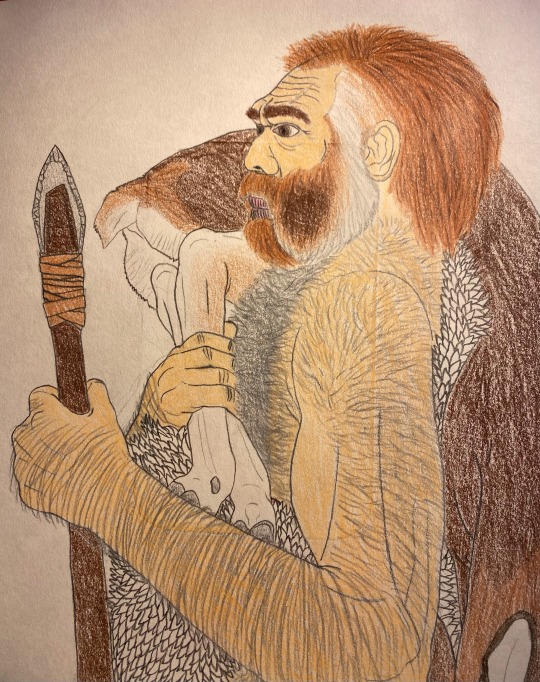
Here’s my illustration of a Neanderthal man carrying a deer that he just hunted in what is now France! Although the upper body of Neanderthals was very similar to that of modern humans, there are some subtle but distinctive differences between their skeletons. The collarbone of Neanderthals is very long, the chest is generally larger and deeper, and the rib cage is slightly flared at the base. The strong arms show marked muscle attachment sites, and the Neanderthal forearm is relatively short. The fingers are short, but the fingertips are broad. The scapula (shoulder blade) is wide from side to side, and Neanderthals most likely had a powerful upper arm swing.
#paleoanthropology#paleoart#pleistocene#neanderthal#homo neanderthalensis#early humans#hominins#hominids#human evolution#paleolithic#hunter gatherer
31 notes
·
View notes
Text
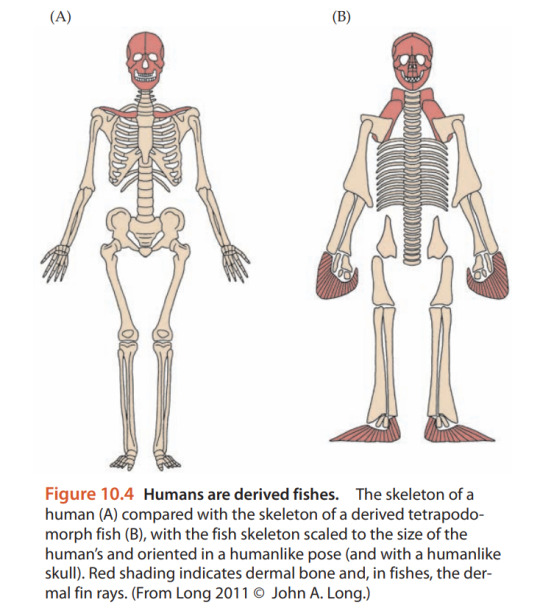
Humans are derived fishes. The skeleton of a human (A) compared with the skeleton of a derived tetrapodomorph fish (B), with the fish skeleton scaled to the size of the human’s and oriented in a humanlike pose (and with a humanlike skull). Red shading indicates dermal bone and, in fishes, the dermal fin rays. (From Long 2011 © John A. Long.)
-- F. H. Pough & C. M. Janis, Vertebrate Life (10th ed., 2019; p. 165)
94 notes
·
View notes
Text

I've found my first review-worthy book of the year!
Eve by Cat Bohannon is a female-focused history of human evolution and a synthesis of pretty much every research field as it pertains to women. It's also readable and witty and one of those rare science books where I actively had to stop myself reading because I had to, say, go to bed.
Simply taking all the scientific research and turning it into layperson language would get this book praise. (You should see how many studies get cited.) Taking that research, relating it readably, and then drawing overarching conclusions? For instance, studies on how and when cis-female bodies produce sex hormones, and studies on how sex hormones affect neurology, and then saying something like, "this is why pregnant people are moodier"? That takes the whole thing to another level.
And it covers so much! It starts with the first mammals, moves through early primates and hominins, draws in studies of mice and apes and history and economics, talks about language and aging, and ends with the evolution of social relationships and thoughts on the future. There's a lot that I found enlightening, engaging, and validating, and a lot of moments where she reframed something and changed my thinking. And she's very comfortable calling out cultures and researchers and ways of thinking (and ducks and chimpanzees) for how they treat their species.
But like all books, it isn't perfect, though with such a subject, it probably couldn't be. For instance, because Bohannon is focusing so much on the average (i.e., cis-perisex) female body, trans and intersex folks don't come up much, though she's very clear that trans women are women, trans men are men, and intersex conditions are not problems. (Also, I'm sure the lack of info correlates strongly to a lack of studies, but she only mentions this a time or two.) *
More importantly, though, given that this is science writing and one expects scientists and writers to back up their claims, she doesn't always. Most of the time when she doesn't, it's clearly speculation or synthesis or some form of "if X, then Y" but sometimes it's less clear. I keep going back here to her statement that the first hominin culture with midwifery had exclusively female midwives. I would absolutely buy this, especially based on some of her points later in the chapter, but she never says why there couldn't have been the odd male. After all, later in the book she also mentions how men-who-help-women could have shifted the dynamics of the band/tribe/group closer to what we see today and that this probably started around the same time. To be fair, jumps like this are fairly rare but they do make me question if there were others I missed or more statements I should have questioned.
So basically, I'm saying this is an important book, and a good book, and a book that should be read by a lot of people, but also a book to read a little critically. Bohannon makes a lot of really great points and relates a lot of intriguing facts and tells some compelling stories about who we are and how we got here. She's done good work with this book and should be proud of it. But also, there might be some spots where her arguments could be tighter.
*she also prioritizes words like "she" and "mother" and "woman" over words like "parent" and "person", which I can see not being great for some trans people even though I understand that she's trying to upend the notion that the average human is a cis male and show that female/afab bodies are pretty important.
#booklr#bookblr#adult booklr#science writing#book reviews#human evolution#hominins#cat bohannon#eve#my photos#read in 2024#non-fiction#book recommendations
26 notes
·
View notes
Text

"The church used to say, 'No, God didn't allow evolution. Instead, he hid the bones in the rocks to test our faith.'
It didn't work out too well. So now they say, 'Now we know about it, it proves how incredibly clever he was all along.'
It's an infinitely elastic airbag, and there's no argument that I can bring or anyone else can bring against it.
And that's what should make you suspicious."
-- Christopher Hitchens
https://www.catholic.com/tract/adam-eve-and-evolution
Concerning biological evolution, the Church does not have an official position on whether various life forms developed over the course of time. However, it says that, if they did develop, then they did so under the impetus and guidance of God, and their ultimate creation must be ascribed to him.
Concerning human evolution, the Church has a more definite teaching. It allows for the possibility that man’s body developed from previous biological forms, under God’s guidance, but it insists on the special creation of his soul. [..] So whether the human body was specially created or developed, we are required to hold as a matter of Catholic faith that the human soul is specially created; it did not evolve, and it is not inherited from our parents, as our bodies are.
Either god thinks whatever man wants him to think, or everyone who claimed to have figured him out was wrong.
#Christopher Hitchens#catholic church#evolution#human evolution#test of faith#mysterious ways#religion#man made god#god is man made#religion is a mental illness
41 notes
·
View notes
Text
youtube
Why are our eyes white? Why are the eyes of our closest relatives dark?
#paleontology#fossils#dinosaurs#scicomm#dinosaur#biology#science#nature#human#anthropology#evolution#human evolution#Youtube
69 notes
·
View notes